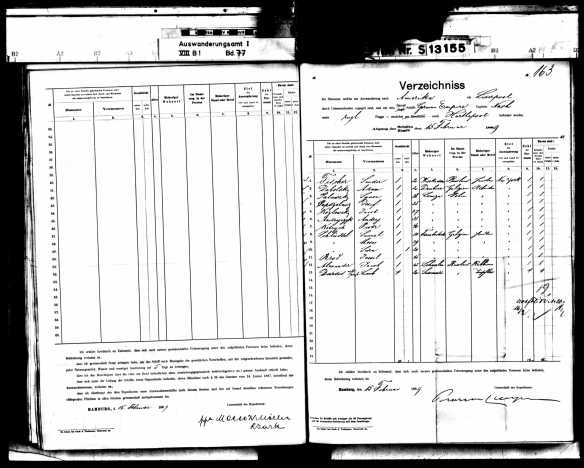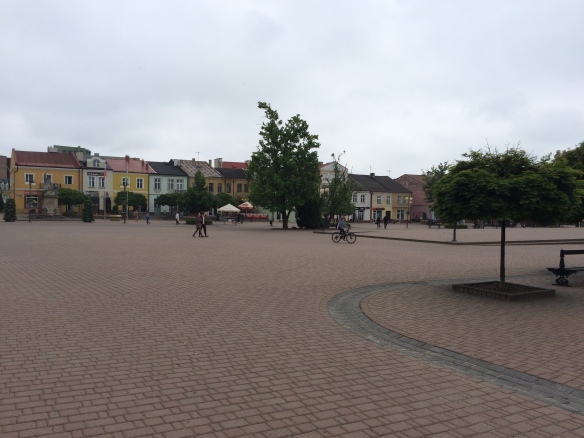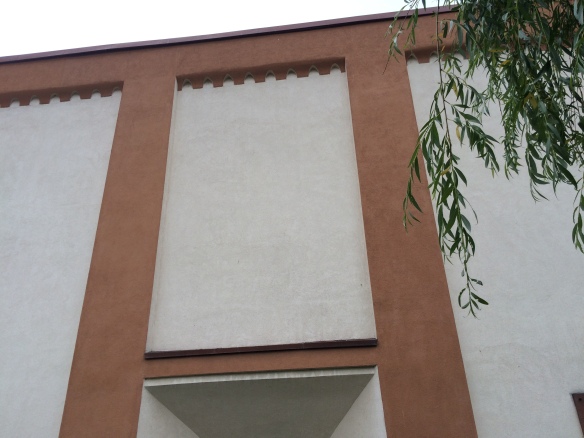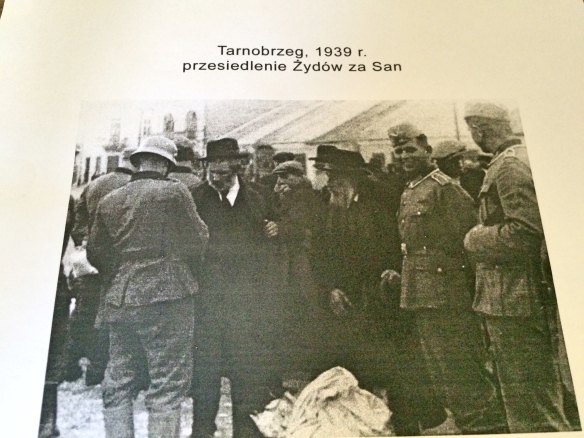My third day in Poland was undoubtedly the highlight of the trip for me. Visiting the town where my great-grandparents lived was the initial motivation for going to Central Europe in the first place. The stops in Prague, Budapest, and Vienna were the icing on the cake, but the cake was Poland and, more specifically, Tarnobrzeg. (I finally learned how to pronounce it, thanks to our guide Tomasz: TarNOBjeg.) I had high and emotional expectations; they were exceeded by the reality.
First, some background. When I first started doing genealogy research, I had no idea where my maternal grandmother’s family had lived in Europe other than they were Galitzianers—from Galicia. My mother had no idea what town in Galicia had been their home, and for a long time the only location given on the records I could find was Austria, which made sense since Galicia was part of the Austria-Hungary Empire when the Brotmans lived there.
Then a few pieces came together—first, I obtained my great-uncle Hyman Brotman’s naturalization application giving his home town as Jeekief, which is a decent phonetic spelling of Dzikow, once a separate village but later incorporated into Tarnobrzeg, a much larger town. Then I found a ship manifest for Yossel Brod, most likely my great-grandfather, from Tarnobchiek, another phonetic spelling, this time of Tarnobrzeg. The ship manifests for my great-uncles Abraham and David Brotman gave their home town at Grebow, a small village less than ten miles from Tarnobrzeg. It seemed clear to me that Tarnobrzeg was the area where my Brotman ancestors had lived in Galicia. And I had to go there.
I had originally hoped that there might be some records left in Tarnobrzeg that had not yet been digitized and put on line by JewishGen, Gesher Galicia, or JRI Poland, but our guide Tomasz warned me that he believed that whatever records still existed had in fact been found already and that we would not find any more in the town. I adjusted my expectations accordingly, and I decided to enjoy the trip for the experience of being there rather than as a research opportunity.
Tomasz picked us up at our hotel at 9 am that morning, and we got to meet my recently found cousin Phyllis for the first time. Phyllis and I had connected through DNA testing, which showed us as third cousins and showed her aunt Frieda and my mother as second cousins. By comparing our family trees we had reached the conclusion that the likely connection was through my great-grandmother Bessie Brot Brotman and her grandmother Sabina Brot, whose father we believe was my great-grandmother’s brother. Sabina’s home town in Galicia was Radomysl nad Sanem, another town about ten miles from Tarnobrzeg, which we would also visit that day. The common surname and the proximity of residences seemed to support our hypothesis. We quickly connected in person, chatting excitedly about our research, our travels, and our hopes for that day.
As we drove from Krakow to Tarnobrzeg, Tomasz spoke about the history of Jews in Poland. By the 19th century Jews made up 10% of the population of Poland, and they lived all over the country—in the cities and in small towns and in villages. The land we drove through was mostly rural even today, and Tomasz said that Jews were often invited by the kings or the aristocracy to live in the towns to support the local economy; Jews had the education and the skills to provide bookkeeping, trade, banking, and other economic necessities to the farmers who lived in these regions. In Tarnobrzeg it was the Tarnowski family that owned the land and invited the Jews to come live there.
When I asked him about the level of religious observance of the Jewish residents who lived in places like Tarnobrzeg, Tomasz said that there was a diverse range of religious observance—-from Hasidim to more traditional Orthodox to more liberal Jews and to secular Jews. Other sources point out that Tarnobrzeg was an important Hasidic center with well-regarded Hasidic leaders and rabbis.
Tomasz also spoke about the fact that Tarnobrzeg was one of the leading Jewish population and industrial centers in Galicia outside of Krakow. The main industry aside from agriculture was the production of sulfur, a product that it still important to the local economy of the region. Tarnobrzeg is located where two rivers meet—the Vistula (which also runs through Krakow) and the San, and thus was an important trade location. It also is very close to what was once the border with the Russian Empire, and when Russia obtained that land, families were often separated, some living in Austria-Hungary, some in the Russian Empire. In the 19th century when my great-grandparents lived there, the population of Tarnobrzeg was more than 75% Jewish. There were about 2800 Jews living there in the 1880s when my great-grandparents decided to leave.
I asked Tomasz why people like my great-grandparents would ever have left a place like Tarnobrzeg, where Jews were doing well and treated well and were more than a majority of the town’s residents. He said that in the late 19th century, there was both an economic crisis in Poland and a significant increase in the population. (There was also a great deal of anti-Semitism in Poland, as other sources describe.) Jews and non-Jews left for greater economic opportunities. When I pondered how a family would be able to tear themselves away from their home, both emotionally and financially, Tomasz explained that there were emigration agents facilitating these departures. They would circulate brochures touting the advantages of going to America, and the fact that many others were leaving made it easier for a family like mine to make a similar choice. I asked how they would actually leave, and Tomasz said there was a train that came to Tarnobrzeg that would take them to one of the port cities, like Gdansk or Hamburg, where they would catch a ship for America. It would be costly, but the potential benefits made it all seem worth the risk.
Finally we arrived in Tarnobrzeg itself. It was not exactly what I expected, as it is a large town, not a little shtetl, and it is a thriving town—lots of people, lots of stores, lots of cars. Not a quiet little romantic village out of Fiddler on the Roof at all. There was even a Lego store right on the main square.
But once we got out of the car and started to walk around, I felt some almost eerie connection—that this was a place where my great-grandparents had walked, had shopped, had worked. Many of the buildings that surround the square were there back in the 1870s and 1880s when my great-grandparents and their children lived there. Maybe one of those buildings contained a shop where my great-grandfather worked (on that ship manifest his occupation was given as “kaufmann” or merchant). Maybe my family lived in one of them.
I stood in that square, imagining it 150 years ago as a place filled with families like my own, Jewish families of all sorts, living in a safe and comfortable way in a safe and comfortable place. I could imagine my great-uncle Chaim who became Hyman and then Herman and my great-aunt Tema who became Tillie, just small children, holding their mother’s hands as they walked through that square. I could block out the Lego store and the ugly modern supermarket and see just the old buildings as they might have looked in the 1880s.
Tomasz took us to the building which was once the synagogue. According to the official Tarnobrzeg website, it was heavily damaged by the Nazis and used to store grain. It was renovated in the 1970s into a public library, and there is almost no sign today that it was ever a synagogue building. The windows were changed, and inside where there was once a prayer hall and aron kodesh are now stacks filled with books. When we asked in the library whether they had any photographs or books or records about the synagogue or the former Jewish community, all they could find was one copy of a brochure that had only been created a few years ago.
Here are some photographs of the building when it was a synagogue:

murals inside synagogue http://www.kehilalinks.jewishgen.org/Tarnobrzeg/html/synagogue.htm

Exterior of synagogue http://www.kehilalinks.jewishgen.org/Tarnobrzeg/html/synagogue.htm
The only visible sign that the building was built as a synagogue is a small plaque on the exterior of the building in a location that almost no one could ever see or read if they were not looking for it. We had to walk around the building through the lawn to get this photograph. The only small comfort was that the building was being used for books and education, not for commerce or worse.
Tomasz also pointed out that the first Jewish cemetery was located just a block away, but was now a parking lot for the shopping area that now exists there. According to this video prepared in 2008, the Nazis destroyed the synagogue and used the headstones to pave a road. (I suggest downloading the hi-def version and watching it; it will give you a better sense of the town and its history.)
We then drove to the other Jewish cemetery in Tarnobrzeg, which was opened in the 20th century and where there is still an ohel with a Star of David. Sadly, the cemetery is not maintained at all, and there are just a handful of headstones still standing, most covered with weeds and snails. I took photographs of as many as I could and now hope to get these translated.
After visiting the cemetery, we went to a small museum Tomasz knew about, where we met with an incredibly helpful woman who did not speak any English, but when Tomasz explained why I was there, she was very excited and anxious to help. She provided us with some books with drawings and photographs of Tarnobrzeg before World War II.
The woman at the museum also explained where Dzikow had been located before it merged into Tarnobrzeg, so we drove there and saw some very old homes, built almost like log cabins. I was enchanted and wondered whether one of these buildings had once been my great-grandparents’ home.
As we left Tarnobrzeg, Tomasz told us what had happened to the Jews there during the Holocaust. Many were shot and killed just outside of town and buried there. Many others were taken to the San River and shot, their bodies falling into the water. The rest were eventually transported to a concentration camp or a death camp. If any survived, they have not returned to Tarnobrzeg. There are no known Jews living there today. What would my great-grandparents, both of whom died before the Holocaust, have thought if they returned to their hometown today? It would no longer be the place they knew in almost any way, except for the old buildings that survive.
I could have stayed and wandered around Tarnobrzeg for hours, but we had two more stops to make: Radomysl nad Sanem and Grebow. We headed first to Radomysl nad Sanem, where Phyllis’ grandmother had lived. It is on the other side of the San River and is a very small little town with a small town square and municipal building and perhaps fifty homes, if that many. Its Jewish population before World War II was less than 400 people, and the village was mostly Jewish. We drove from one end of the town to the other, and it took only a few minutes. Even more so than in Tarnobrzeg, there is no sign that there were ever Jews there. Phyllis was able to obtain some brochures about the town from the library there, but nothing that discussed the former Jewish community.
Our last stop was a quick one in Grebow, a town even smaller than Radomysl nad Sanem where there was not even a library we could visit. I don’t know whether this was where Abraham and David Brotman were born or simply where they were living at the time they emigrated. Perhaps they had moved here for greater opportunities than they could find in Tarnobrzeg. I don’t know. It’s such a tiny village that all I can do is imagine them living there and then wonder what they must have thought when they landed in a place as large and crowded and dirty as late 19th century New York City’s Lower East Side.
We then headed back to Krakow. I was exhausted and emotionally drained and filled with thoughts and feelings. We were taking another night train that night, this time to Budapest. As we ate a quick dinner at our hotel, I found myself overwhelmed with emotion in a way that surprised me. My eyes filled with tears—tears for the people who had been killed, tears for my great-grandparents who had left this country for better things, tears of gratitude that they had done that, and tears of sadness that I was leaving a place that part of me truly felt was my homeland.












































Great!
Gerry Ross
>
LikeLiked by 1 person
Thanks, Gerry!
LikeLike
Thank you for sharing.
LikeLike
Thank you for reading!
LikeLike
I feel emotionally exhausted just from reading this account, Amy. The photographs are wonderful. Tomasz really seems knowledgable.
LikeLiked by 1 person
Thank you, Luanne. Tomasz was fabulous.
LikeLike
It is almost impossible not to feel emotionally connected — and exhausted — when walking the streets of our ancestors. I’m so glad you have been able to have this ultimately enriching experience after all the hard work you have done. All the best for the rest of your trip, Su.
LikeLiked by 1 person
Thanks, Su! (We actually came home two weeks ago—I just have been slowly writing up my thoughts about the trip day by day.)
LikeLiked by 1 person
Thank you, thank you… even though the towns were different, I felt that I was seeing my family’s towns too. They were from Makov/Makof, about 45 km from Warsaw.
My cousin went there about 30 years ago and couldn’t find a single shred of evidence that Jews ever lived there. It was her mother’s birthplace so she had much information before she went. The inhabitants that she spoke to and questioned, all denied that Jews have ever lived there.
My grandparents left in 1908 and their siblings followed a few years later. The relatives who remained, were all murdered by the Nazis.
We were in Warsaw last year with a group from the San Francisco Jewish Community Center and I had planned to take a train to Makov. Our local guide said that there was no point in going, as there was nothing left of the former Jewish community, which had been about 1/3 of the population before the war. He said that when the Jews were there, it had been a vibrant, cultured town, but since all of the remaining Jews had been murdered, the town is now not at all interesting. The only reminder that Jews once lived there, is the bus station that is paved with Jewish headstones, turned over of course.
He seemed to know a lot about Makov’s history and said that we would learn more about Polish Jews by spending that time in Warsaw and after my cousin’s experience years before, we did as he suggested.
Will I ever go back to Poland again, I doubt it, but if I do, this time I will definitely go to Makov. Even if there are no Jewish or family places left to see, at least I too will walk in the footsteps of my ancestors.
LikeLiked by 1 person
Thanks so much for sharing your thoughts and your own story, Nina. I am sure you did get a lot out of being in Warsaw. We didn’t get to Warsaw, but maybe we will if we ever get back to Poland. The new museum is supposed to be excellent.
LikeLike
Amy, we visited the old Jewish cemetery in Warsaw. It is HUGE and like a jungle. Many volunteers over the past few years have cleared out areas and cleaned up the headstones, but there are thousands left that are still untouched.
It was a Holocaust themed tour … enlightening but very somber… Latvia, Lithuania and Poland. Krakow has a new, beautiful center with many activities for seniors and people who recently found out that their families had been Jewish. We also went to Auschwitz…. WHEW .. that is an experience.
The new museum Warsaw is excellent and well worth seeing.
I doubt that we will go to back to Poland again … there is nothing left of most of our families and it certainly isn;t a ‘tourist’ destination as you know.
One member of our group hired a Lithuanian guide from home and was actually able to go to her the exact house where her great grand parents had lived. Her family had the address.
You are so lucky to have found your cousin… a miracle for both of you.
Nina
LikeLiked by 1 person
Thank you, Nina. That sounds like a very meaningful tour. As you can see on the blog, we visited Auschwitz and Terezin. Very painful.
LikeLike
An amazing post, Amy. I’m dismayed about how little of the local history has been preserved; if we don’t know the history, we’re doomed to repeat it, so the saying goes. Your work on this blog is so important, well beyond your family.
LikeLike
Thank you, Leslie. You are right about learning the lessons of history. One encouraging thing that I learned on our trip is how extensive and mandatory Holocaust education is in Europe. I am not sure the US is doing as good as job.
LikeLiked by 1 person
Amy,
good news: http://www.jpost.com/Diaspora/The-resurgence-of-Jewish-life-in-Poland-406073
As I mentioned before, I have my difficult personal reasons to care about Jewish history in Poland.
Experiences can differ greatly, depending on the individual place. Even small towns have taken up responsibility.
In cooperation with Jewish survivors, I was personally involved in this cemetery project: https://en.wikipedia.org/wiki/Jewish_cemetery_of_Chrzan%C3%B3w
I have seen this synagogue about 10 years ago, almost as a ruin: Look at it now!!
http://kehilalinks.jewishgen.org/dabrowa_tarnowska/
And Polish people took up the task to create webpages:
http://www.kirkuty.xip.pl/indexang.htm
http://www.kirkuty.xip.pl/tarnobrzeg.htm
LikeLiked by 1 person
Thank you, Dorothee! These are all very encouraging developments. We went to the JCC in Krakow, as I mentioned. There is hope, although the numbers are low. I had not seen the Jewish cemetery website about Tarnobrzeg—thank you so much!!
It’s interesting—on Facebook, some people responded that they cannot understand why anyone would ever return to Poland or any of the places where Jews were erased from the map; I feel strongly that we not only can go to these places, but that it’s important to remember and to remind others that there once were millions of Jews living in these places.
Thanks again!
LikeLike
Prior to my trip I was hesitant about going to Auschwitz. Then I knew it was my duty to go and stand on those bloodied grounds and say out loud….’I am here you bastards ….you thought that you got us all, but I am proof that you failed.’
LikeLiked by 1 person
Exactly.
LikeLike
Lovely blog entry, Amy, thank you – a great day and a wonderful keepsake for me!
Your 3rd cousin, Phyllis
LikeLike
Thanks, cousin—and thanks once again for helping to make it such a meaningful day.
LikeLike
A very evocative account of small-town Poland, thank you. My wife’s ancestors on the paternal side were Bocianowskis, and they lived near Krakow before the second world war, when her father was interred in a Russian labour camp. It is hard from this side of the ditch to realize the devastation the Nazis wrought upon the Jewish population: whole towns without any Jewish residents is just inconceivable!
LikeLiked by 1 person
The ditch being the English Channel? That’s interesting since I think of England as being so much closer to war than the US, but fortunately the Nazis never got to the Jews in Great Britain either. Thanks for your thoughts.
LikeLiked by 1 person
Reblogged this on Janet’s thread.
LikeLike
Thank you!
LikeLike
So very interesting to see the photos of RnS, as that is where my maternal grandmother Esther Malke (nee Abromowitz) Shupler was born in 1889.
LikeLiked by 1 person
I hope you and Phyllis can connect! Such a small world.
LikeLike
Amy, I am delighted to find and follow your blog. This posting has given me the very first view of a place in what was once Galicia. My Great Grandparents were from the towns of Sambor and Boryslaw, also in Galicia. I will study this posting more and look forward to learning more.
LikeLiked by 1 person
Hi, EmilyAnn, and thanks for reading and commenting. I am going to go check out your blog!
LikeLike
Hi, Amy,
What a fascinating blog and I am so glad I came across it. Like you I am passionate about genealogy, In fact, next week I will be making my first visit to an “ancestral” town, Tarnobrzeg—which is what brought me to your blog post. I had a few short questions about your own trip to Tarnobrzeg, was wondering if you’d mind if I email you? If so please reach out to me at …… Many thanks.
LikeLiked by 1 person
I will email you. I deleted your email address from the comment for privacy reasons.
LikeLike